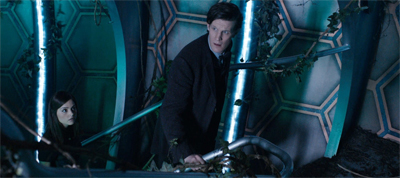To celebrate the fiftieth anniversary of the longest-running science-fiction show in the world, I’ll be taking weekly looks at some of my own personal favourite stories and arcs, from the old and new series, with a view to encapsulating the sublime, the clever and the fiendishly odd of the BBC’s Doctor Who.
The Five Doctors originally aired in 1983.
There was one chap we tried to get hold of. What was his name? Used to be your scientific advisor.
Oh, the Doctor.
Yes that’s right.
Wonderful chap. All of them.
– Crichton and the Brigadier get into the spirit of things
The Five Doctors is a big anniversary celebration for the franchise, reuniting all five… er, four… er, three of the actors to play the lead role and one guy in a dodgy wig. Written by Terrance Dicks, The Five Doctors is 100 minutes of pure celebration, without too much in the way of depth or drama or development. It’s a beautifully packaged “greatest hits” collection for the franchise, to the point where the generally nostalgic atmosphere of the rest of the twentieth season (pairing up the Doctor with foes from his twenty-year history) can’t help but feel a little a little shallow in comparison.
Producer John Nathan Turner and script editor Eric Saward tended to fixate a bit too heavily on the show’s history and its continuity, with stories often becoming oppressively burdened with in-jokes and references to events that took place decades ago. In contrast, Dicks is able to craft a healthy slice of nostalgia that remains accessible and enjoyable, giving everybody their moment in the sun.
Well, everybody but the Cybermen.
Filed under: Television | Tagged: bbc, Brigadier, Caves of Androzani, Dalek, doctor, doctor who, DoctorWho, Five Doctors, Jo Grant, john hurt, John Nathan Turner, Jon Pertwee, Master, patrick troughton, paul mcgann, Sarah Jane Smith, second doctor, terrance dicks, Third Doctor, Time Lord, Tom Baker, utopia, War Games, Web of Fear | 1 Comment »
























